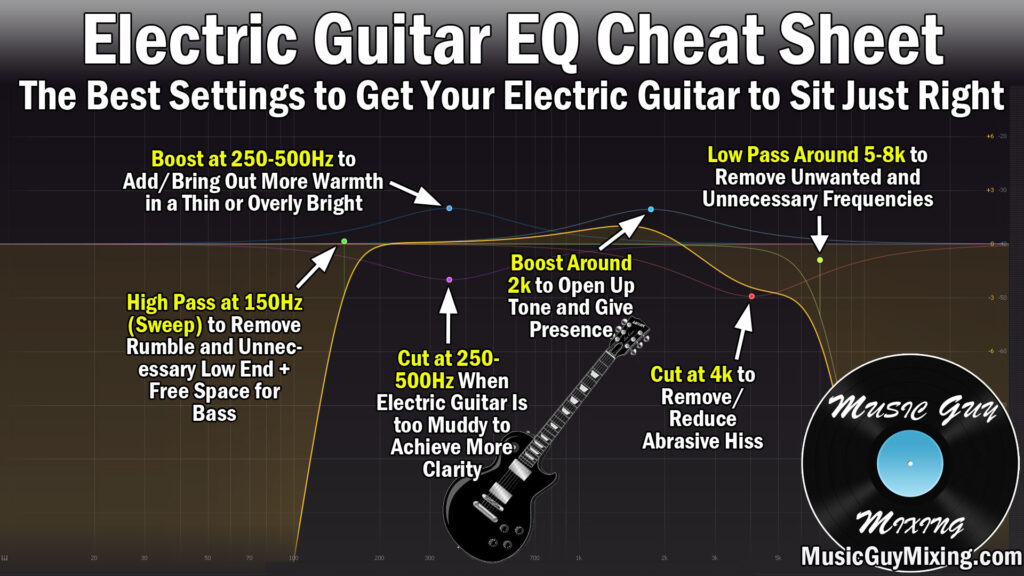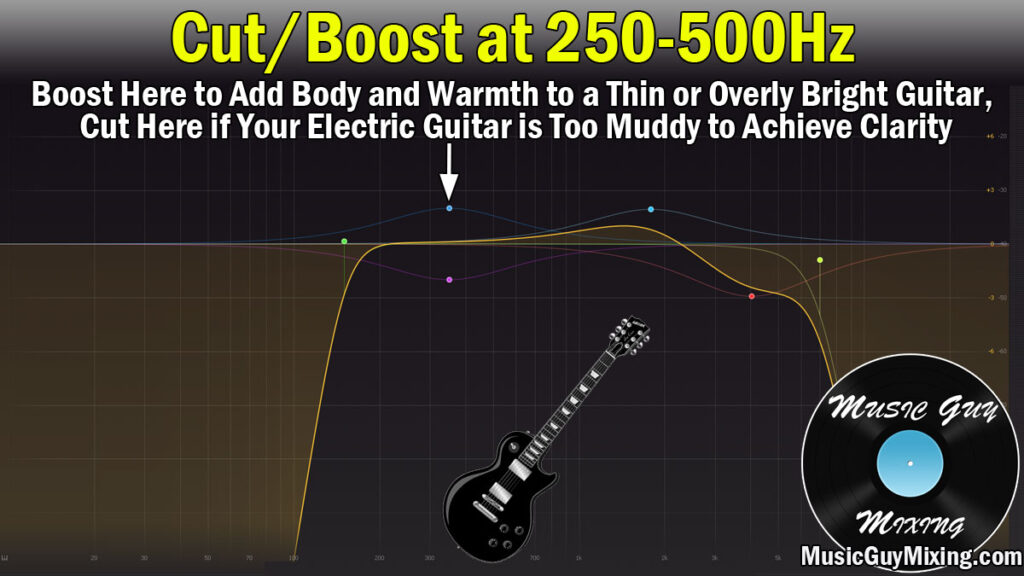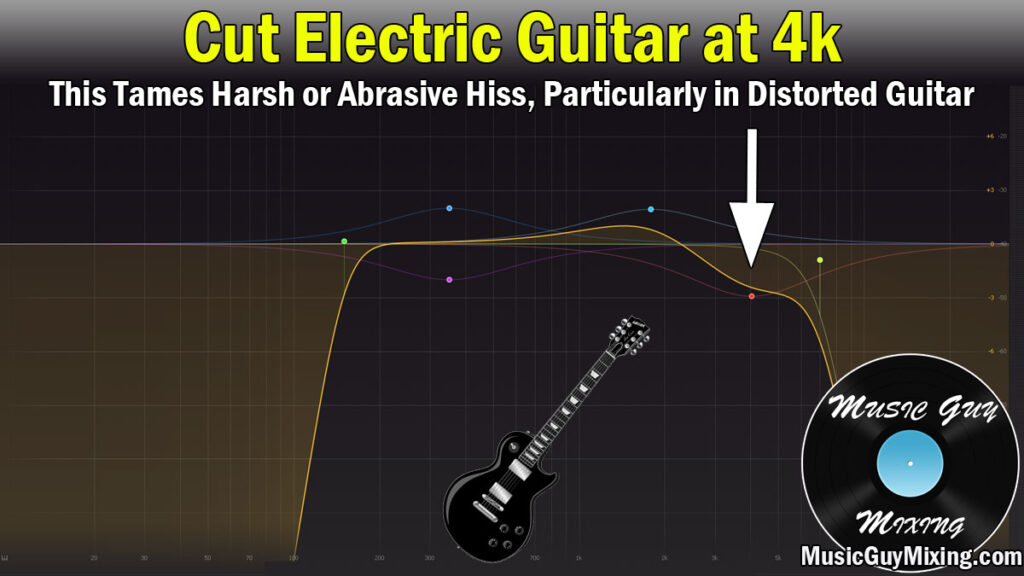Electric guitar is one of the mid-heaviest instruments in a typical mix. There are a lot of different ways to approach electric guitar EQ, and after years of trial and error, I’ve put together this electric guitar EQ for getting the perfect tone every time.
Electric Guitar EQ
Electric guitar can create a lot of mud and with it a lot of headaches when you’re mixing. Sometimes the tone you’re working with is too dark and muddy, or conversely too bright, thin, or even harsh. I’ve put together this electric guitar EQ cheat sheet to show the best places to cut or boost on your track to get presence and clarity.
This isn’t meant for copy and pasting on your track and expecting it to sound perfect, but it’s an excellent place to start.
Electric Guitar EQ Cheat Sheet

Now let’s talk about each point in the electric guitar EQ cheat sheet to explain WHY I’m recommending each move and what they do. My go to EQ and the one used for every graphic is the FabFilter Pro-Q, but these moves can obviously easily be replicated using your favorite EQ.
Refer to my overview on the 6 EQ filter types to supplement this guide.
High Pass at 150Hz (Sweep From Here)
First let me acknowledge that, yes, I know that the lowest note on a guitar is typically tuned to roughly 82Hz. And yes, I’m still telling you to START sweeping at 150Hz with a high pass filter.

You should try sweeping that filter up and down, playing the guitar in the context of the mix.
Is the guitar disappearing, or is the mix sounding cleaner by way of tidying up that low end? There’s a lot of rumbling associated with the low end of a guitar, especially on distorted chords.
It’s similar advice which I gave in my recent guide on how to EQ acoustic guitar.
For busier mixes where I’ve got a lot of tracks, I’ll sweep higher and leave everything below 150Hz entirely for the bass. Incidentally, check out my bass guitar EQ guide on how to really clean up your low end and with it your mix.
If it’s a sparser mix with less tracks, I’ll roll the high pass back lower to keep more of that low end intact. In those cases the mix can benefit from that fatness on the low end.
Remember there’s only so much space to go around in a mix, so sweep and decide how much of that thick low end you need and sounds good (in the context of the mix).
Still, give it a try. Let the guitar and bass work together to complement one another as the bass works low and the guitars populate the low-mids. You might be surprised how you didn’t need the lower frequencies on the guitar you thought you did.
Cut or Boost at 250-500Hz
This is the where the thickness of the electric guitar inhabits.

If the guitar sounds too thin (even after considering the high pass from the last point), try a small boost in this range.
Conversely, too much prominence in this range and that thickness quickly turns into boxy mud. If that’s the issue, try a small cut here before adding higher frequencies.
Cutting here is not unusual. It’s commonplace in a lot of modern rock to really scoop out the low mids on guitars to create a natural emphasis on the clarity-lending frequencies.
Boost at 2k to Give Presence
The 2k area has a bit of magic to it on a lot of electric guitars.

When you need a little extra life out of an otherwise bland guitar, try even a small boost here.
Cut at 4k to Remove Hiss
There’s a nasty hiss which sometimes comes out on distorted signals at 4k which can fatigue the ears fast.

Like with everything in mixing, it helps to have a reference track of electric guitar that you like the sound of so you can keep that context.
My mentioning that at this point is no coincidence. Before I would use references I’d let those high frequencies get out of control and compared to well mixed guitars it would sound like a buzz saw (not a good kind).
Low Pass Electric Guitar at 5-8k to Remove Unnecessary Frequencies
Low passing your electric guitar is important, but the exact location is more of a judgement call.

For distorted guitar, I tend to pass on the lower side in the 5-6k region. When using electric guitar EQ, remember that there are a lot of instruments where everything 5k and above are much more important. Filtering this out here creates space for vocal air, cymbal sizzle, and the occasional pad or other synth part.
Electric Guitar EQ Tips
- Use electric guitar EQ to address problem frequencies, reduce the bad, and bring out more of the good tone you want.
- Begin by high passing around 150Hz. Leave this room for the bass, and sweep higher in busier mixes.
- Boost between 250-500Hz to bring out body and warmth of electric guitar.
- Cut between 250-500Hz to achieve clarity in a muddy electric guitar.
- Boost around 2k to open up the tone and add presence.
- Cut at 4k to mitigate or outright remove abrasive hiss.
- Low pass around 5-8k to further curb and overly bright guitar and leave those frequencies to more deserving elements such as vocals and cymbals.

Pingback: Bass Guitar EQ Guide to Perfect it Every Time - Music Guy Mixing
Pingback: How to Beef Up Thin Guitar - Music Guy Mixing
Pingback: How to Mix Electric Guitar - Music Guy Mixing